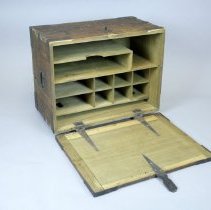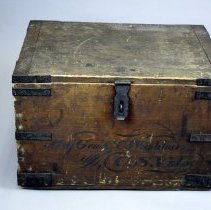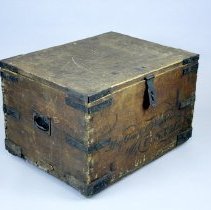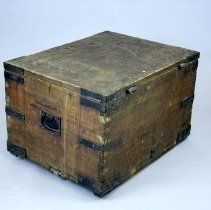Object Record
Images





Metadata
Object Name |
Desk, Portable |
Catalog Number |
1913.008.01 |
Description |
Cadwallader Colden Washburn's Civil War field desk. There are three metal brackets on each corner with dovetail corners and two iron strap hinges and a hasp. Pigeon holes inside-one larger file holder on top, eight divided compartments below. Two handles-one on each side. Black text on the front reads "Maj. Genl. C. C. Washburn" and the line below "U.S. Vols." Decorative swashes around text. |
Other Name |
Field Desk |
Year Range from |
1862 |
Year Range to |
1865 |
Provenance |
This desk was used by Major General C.C. Washburn during the Civil War. |
Used By |
Cadwallader Colden Washburn |
Event |
Civil War |
Material |
Wood, Metal |
Dimensions |
H-15 W-24 D-18.25 inches |
Height (in) |
15.000 |
Width (in) |
24.000 |
Dimension Details |
Dimensions were taken how it would be stored. |
People |
Washburn, Cadwallader |
Subjects |
"Things that Matter" Military Work |
Search Terms |
"Things that Matter" Civil War |
Relation |
Show Related Records... |
Notes |
At one time may have had a writing surface (other field desks have them). "Things that Matter" article from the La Crosse Tribune: "At first glance, this appears to be a simple wooden crate with writing on the side. As soon as it is rotated onto its side and opened, it goes from being a simple crate to an easily transportable Civil War field desk used by a general. Cadwallader Colden Washburn was born in Livermore, Maine in 1818. During his early adulthood, he moved to the Midwest and moved between Illinois and Iowa, until finally settling in Mineral Point, Wisconsin in 1852. Washburn worked as a schoolmaster, surveyor, lawyer, and United States Congressman before settling in La Crosse in 1861. In February 1861, Washburn served as a delegate to the Washington Peace Conference in a final attempt to prevent the Civil War. The conference served as a good faith attempt to re-unite the United States and resolve differences between the two sides through compromise. The South had already planned to secede from the Union and was preparing a new government, and ultimately a decision on slavery could not be made that would satisfy both sides. A few months later in April 1861, the Civil War officially started after a Confederate attack on Fort Sumter. Washburn accepted an appointment as colonel of the 2nd Cavalry and led it to Arkansas in the spring of 1862. He was promoted to brigadier general in June 1862, and was put in command of the entire 2nd Cavalry Brigade. Less than a year later, in March 1863, Washburn was commissioned a major general with command over all the Union cavalry in West Tennessee. After the war, Washburn left the military and returned to Congress from 1867 until 1870. In 1866 he co-founded the first flour mill in Minneapolis, Minnesota, the Washburn-Crosby Company. Today that flour mill is known as General Mills. Washburn also served as the eleventh governor of Wisconsin from 1872-1874. He died in Eureka Springs, Arkansas in 1882 while recuperating from an illness. This former governor and Civil War general is buried in Oak Grove Cemetery. In 1885, over 3 years after his death, the Washburn estate erected the obelisk beside his grave. The 55-ton monument is engraved on all four sides of its base with a description of Washburn’s accomplishments. He made significant contributions as a public servant to his home of La Crosse, to the state of Wisconsin, and to the United States, through his military service, political career, and generous philanthropy. The black text on the front of the field desk reads "Maj. Genl. C.C. Washburn U.S. Vols." and dates from after his promotion in 1863 to major general. It would have aided Washburn in organizing the paperwork required of a major general. This desk would have likely been used by the general for the writing of correspondence and reports. Washburn’s obelisk commemorates his life story and ensures that he will not be forgotten. This field desk does the exact same thing without weighing over 100,000 pounds. It is a part of the story of Cadwallader Washburn’s life and La Crosse’s involvement in the Civil War." This article was originally published in the La Crosse Tribune. Title: Major General C.C. Washburn’s Civil War Field Desk Author: Amy Vach Publish Date: July 22, 2017 b. Livermore, Maine, April 22, 1818 d. Eureka Springs, Arkansas, May 15, 1882 Cadwallader Colden (C.C.) Washburn was a U.S. Congressman, Civil War officer, industrial empire builder and founder of General Mills, and 11th governor of Wisconsin. Few people of his generation had as much influence on Wisconsin history. Early Life Washburn grew up in Maine. He taught school there before moving to the Midwest to seek his fortune. He worked in Iowa and studied law in Rock Island, Illinois, before settling in Mineral Point, Wisconsin, in 1842. He opened a law practice, founded a bank, and acquired a vast amount of northern Wisconsin forest. Washburn, a Republican, served in the U.S. Congress from 1855-1861, and again after the Civil War, 1867-1870 (five terms in all). At the same time, he broadened his business operations in banking and real estate. Early in 1861 he moved to La Crosse and was sent as a delegate to an unsuccessful peace convention held in Washington, D.C., that had hoped to prevent the impending Civil War. Civil War Service After the outbreak of hostilities, Washburn accepted an appointment as colonel of the 2nd Wisconsin Cavalry, on October 10, 1861. The following spring he led it south into Arkansas to join Union forces in the West. Washburn was promoted to brigadier general in June 1862. He took command of not only of his regiment, but also the entire 2nd Cavalry Brigade. On July 7, 1862, it defeated Confederate forces at Cotton Plant, Arkansas, and then marched east to take possession of Helena, Arkansas. From there it supported the Union campaign against Vicksburg, Mississippi. In March 1863 Washburn was commissioned a major general with command over all Union cavalry in West Tennessee, headquartered at Memphis. After the Siege of Vicksburg in the summer of 1863, Washburn's command was moved to New Orleans. In August he led 16,000 men in support of the Red River Expedition, occupying and pacifying large areas along the Texas Coast. He spent most of 1864 and the spring of 1865 in command at Memphis and Vicksburg. Postwar Career After leaving the military in May 1865, Washburn returned to La Crosse and served again in Congress, from 1867 to 1870. He was elected governor of Wisconsin in the fall of 1871 and served from 1872-1874. At that time, there was movement by farmers for government regulation of railroads to alleviate the monopolies of railroad barons. Washburn made some decisions that alienated the farmers, railroad barons and other constituents. This, combined with his veto of a popular construction project, led to his defeat in the 1873 gubernatorial election. After an unsuccessful bid for the U.S. Senate in 1875, Washburn retired from politics. Afterward, Washburn devoted himself to business enterprises. In 1866, he opened his first flour mill in Minneapolis, Minnesota, which became known as General Mills. It was spectacularly successful and flourished for over a century. He also worked in the lumber industry and helped secure the construction of the Minneapolis and St. Louis railroad. Washburn served as a regent of the University of Wisconsin and president of the State Historical Society of Wisconsin. He died in Eureka Springs, Arkansas, on May 15, 1882, while recuperating from an illness. From: Wisconsin State Historical Society http://www.wisconsinhistory.org/Content.aspx?dsNav=N:4294963828-44294963805&dsRecordDetails=R:CS3284 [Source: Dictionary of Wisconsin Biography (Madison, 1965); Love, William D. Wisconsin in the War of the Rebellion (Madison, 1866): 743-746, 895-896; Quiner, E.B. Military History of Wisconsin (Chicago, 1866: 408-409.] |